Timeline marker and everything leading up to it
In this article we will learn everything bottom up, starting from the new backbone added to UnityEngine.Playables that enabled the marker implementation in UnityEngine.Timeline. Not just that, I will rewind back to the very root. What is a playable? Why is that a graph?
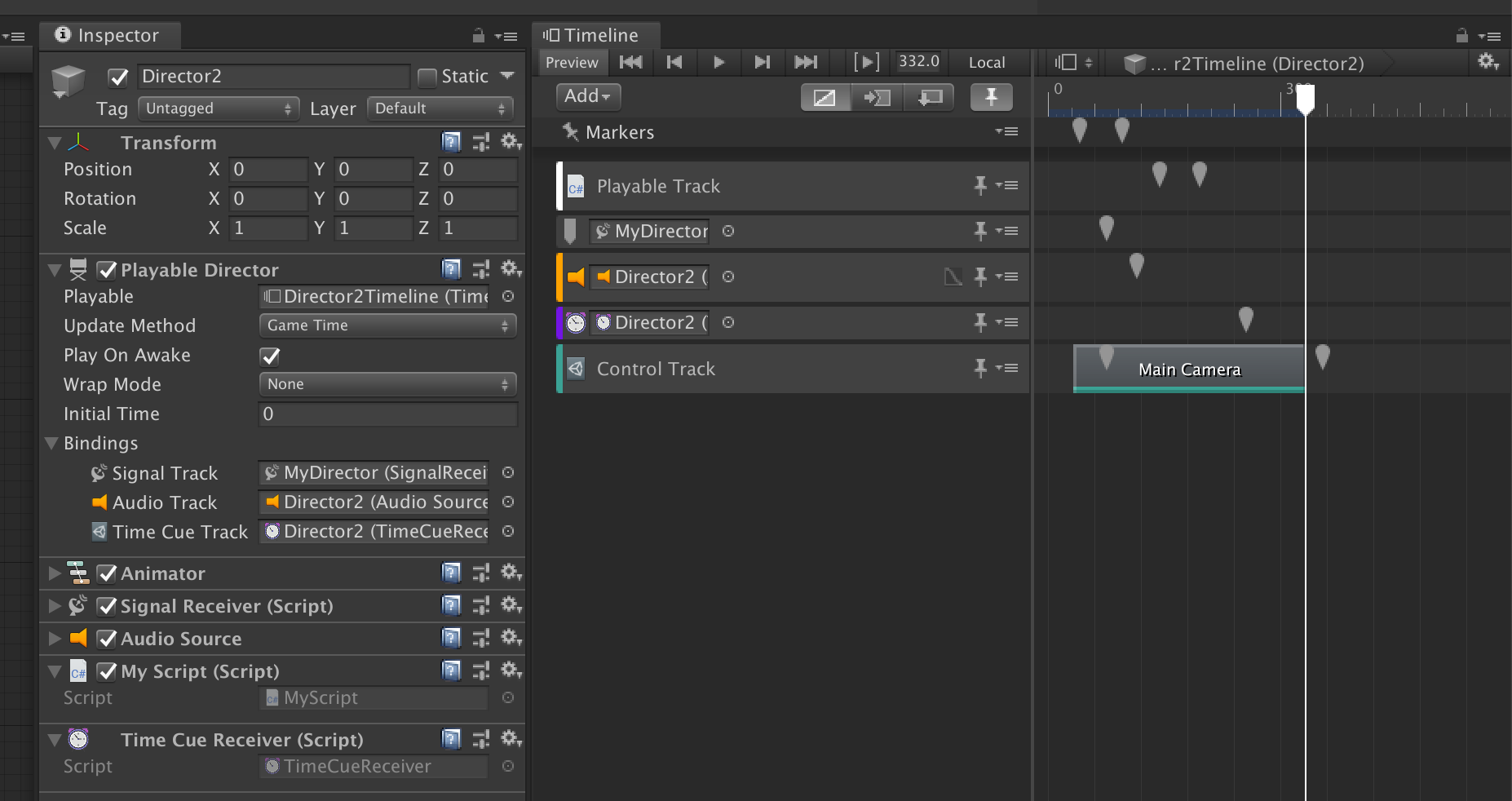

New in Unity 2019.1, you can now create a duration-less object on the timeline, the marker. Currently the official documentation is still not up, but this 2 forum posts could kickstart you what it is.
https://forum.unity.com/threads/new-in-2019-1-timeline-signals.594142/
https://forum.unity.com/threads/new-in-2019-1-marker-customization.594712/
If you are confused by "marker" or "signal" feature (not the same thing), here's the technology stack involved from bottom to top :
UnityEngine.Playables: playable graph, playable, playable asset, playable directorUnityEngine.Timeline: track, clips, timeline assetUnityEngine.Playables(new in 2019.1) : notification, notification receiversUnityEngine.Timeline(new in 2019.1) : markers, marker trackUnityEngine.Timeline(new in 2019.1) : signals
In this article we will learn everything bottom up, starting from the new backbone added to UnityEngine.Playables that enabled the marker implementation in UnityEngine.Timeline. Not just that, I will rewind back to the very root. What is a playable? Why is that a graph?
What is a "playable"
This is one of the most difficult and beginner unfriendly API to learn in my opinion given how abstract it is. ("Timeline" is the beginner friendly abstraction over this, but it helps to understand playables.)
Moreover a "graph" (PlayableGraph) seems not like a thing that could be played at all. (https://docs.unity3d.com/Manual/Playables-Graph.html)
https://docs.unity3d.com/Manual/Playables.html
The characteristic of things that you could "play" :
- You can order it to play, stop, pause, resume. It is said to be in one of these states. (Resume is not a state however, used to enter play from pause)
- It has a built-in time.
- That time moves or not depending on its state.
- Based on this time it do something.
- Based on that do something, the output state is now at something.
How a graph come into play in all this? Why we not just call em "a playable" but instead, "a playable graph"? Imagine a record player. This is definitely a playable thing (literally, and also correctly in Unity's term).

But also, this thing is a graph (that could be played). Graph is made from interconnecting nodes, in this case, interconnecting Playable (that's the actual class name). Many things inside a record player (playables) do connect to make the whole thing (graph) work.
PlayableGraph
There is no new to call, you instead do static call PlayableGraph.Create() and you will get one which you could .Play(). It does nothing however! Until you add some Playable to the graph. There is no .Add(playable) to call either, you will learn how in a bit.
There are several mode of increasing its time it could use : https://docs.unity3d.com/ScriptReference/Playables.PlayableGraph.SetTimeUpdateMode.html
Important
PlayableGraph is playable (adjective), but not a Playable (the class name). ...yeah it even has .Play() if that confuse you further, but Playable as in the class name, means things that are inside the graph that do things, and make output become something while the graph is playing/evaluating.
ScriptPlayable : Playable
But just Playable is boring, it couldn't do anything. Each playable node should has its own behaviour as the time goes on. To create a playable that behave we need a ScriptPlayable, defining how it behave.
Creating this is easy, with static method ScriptPlayable<T>.Create(graphThatItShouldGoTo). (Unintuitively, you don't do something like : graph.Add(new ScriptPlayable<T>()))
How to define the behaviour of the created playable? The secret is in that T generic, which is should be of type PlayableBehaviour. You could imagine it will be able to use your T to create "a piece of logic" embeded in your ScriptPlayable without you having to mess with any delegate to send a method in. Sure enough, PlayableBehaviour is an abstract class that ask you to provide the required logic.
Back to the record player analogy, it must contain tons of ScriptPlayable :
- The first node is the disc providing you data.
- The needle node connects to the record, picking up vibration.
- Imagine graph's time (playable graph has a time) as the position of this needle.
- The vibration is sent through metal strip node.
- The metal strip is connected to amplifier node to change little vibrations to music.
- The amplifier is connected to the speaker.
- Maybe you could even think the speaker is also connected to "air" node, before connecting to your ear.
- Your ear is a playable output node.
If you change the needle's position, you are going to receive a certain kind of output (music) if it is in a playing state. Playing is just a loop of change time -> evaluate. You could also just evaluate the graph while in stopped state. Your choice.
Creating that record player
In simplified steps :
PlayableGraph.Create: You get a thing that could "play" (.Play()), but there is nothing in it yet. You get back agraph.???Playable*Output?*.Create(graph): UseCreatestatic method to put things in the graph. You do get back thatplayable, but thatplayableis already in agraph.- Connect playables up while they are already inside the graph : the returned
playablefromCreatewould have something to do this. For examplePlayableOutputgain these methods. ThePlayableGraphitself contains something likeConnectamong other things. - Graph could branch! From my description you may think things are just connected in a linear fashion. How about having multiple speakers using the same needle's vibration? This is why it's "playable graph" not "playable list".
This is a quite nice recap once you know all the terms so far : https://docs.unity3d.com/ScriptReference/Playables.Playable.html
Looking at Connect's API, you can see that it will get pretty difficult to "imagine" a graph from these "ports". You must ensure something is leading up to the output at least too. You want some sort of GUI to work with this. But before that, needed for the GUI is the ability to "save"...
PlayableAsset
You might be thinking about storing some kind of "preset" and have that create a Playable for you. Storing things in Unity should be via a ScriptableObject.
Luckily PlayableAsset is exactly what you want and it inherits from ScriptableObject too. Instead of static Create you would have to use when crafting out the playable manually from the playable class, now you can use instance method from this loaded asset : playableAsset.CreatePlayable(graph, gameObject) so that it use information serialized in the asset to create a part of graph. Note that inside the CreatePlayable method, you likely have to use Create static method anyways. But having settings saved is better than pure scripting.
PlayableDirector
With the PlayableAsset technology you could have an asset ready to become a graph at any time. In Unity when you have an asset it means you could drag and drop it. (And increasingly Unity is heading towards this "asset" workflow on many packages)
Without PlayableDirector, these are total steps of making use of the PlayableAsset :
- Get the asset in the script. Maybe you use an exposed field because you know
ScriptableObjectdo show up in editor, or you could useResources.Loador Addressable Asset System. - Create a playable graph for it :
PlayableGraph.Create - Create a playable from that asset and put it in the graph :
asset.CreatePlayable(graph) - Connect ports and outputs.
There is already drag and drop in the 1st step, but it would be nice if you could drop the asset somewhere and that thing do all 4 steps for you. PlayableDirector is that.
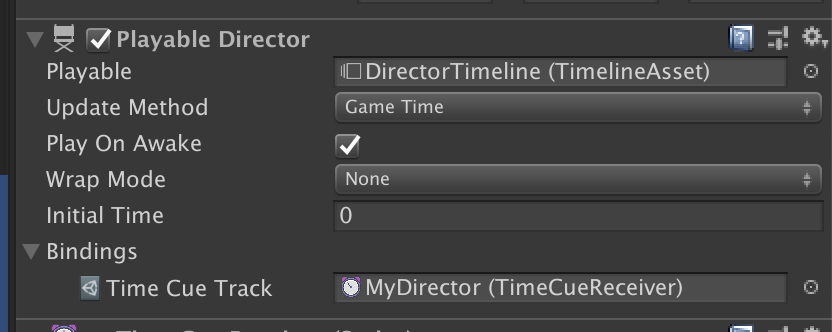
PlayableDirector is commonly thought as "the timeline player", but because you already learn things from bottom-up, we are not even arriving at the Timeline yet. Also notice the top field did not say anything related to "timeline" in general but just "Playable (asset)".
What it want is any PlayableAsset. It creates an empty playable graph and put that playable resulting from the asset to the graph. It doesn't even hand you back the graph (though you could get it) but has its own Play(), Stop() and the like. (Which I guess will be forwarded to playable graph's own Play() anyways)
It just happen that the most common kind of PlayableAsset you give the director is a serialized timeline asset called TimelineAsset (more on this in a moment), and its CreatePlayable returns you a big-ass stack of playable representing the whole timeline.
Bindings
The 5th important step that a PlayableDirector could do : the bindings. The assets in Unity are stored in the asset folder. They have no knowledge of things in the scene! But this PlayableDirector is a MonoBehaviour, it could know something in the scene.
Then we can finally bridge asset workflow with the scene workflow, how about we remember scene-things on the PlayableDirector along with where it should went to when the asset became a playable graph at runtime. When PlayableDirector made a graph, it could additionally "inject" some references from the scene along the way.
By this, bindings are not possible to set in the Timeline GUI without PlayableDirector, as it is not really a timeline's feature. You can think the bindings you can set in the Timeline GUI tab doesn't really modify the timeline asset but modifying the PlayableDirector component's data. Here is an image showing PlayableDirector holding the bindings, not the TimelineAsset. (Which it is also holding, preparing to turn it into the real Playable to uh... play)
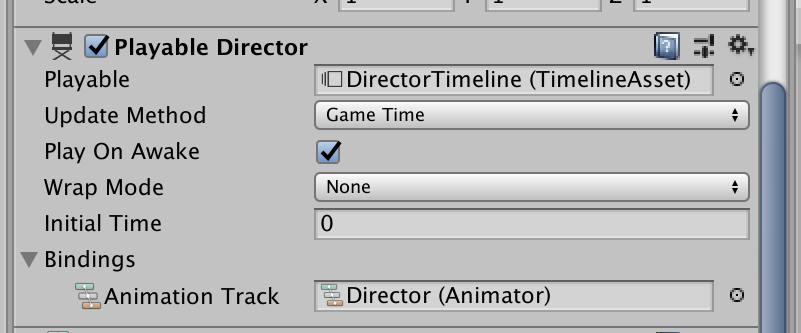
Timeline
What you really want to do is drag and drop things in GUI at design time, preview it along the way, save that thing in the project, then play it when you want, and have something in the scene changes according to that.
Timeline feature is this. It consist of a dedicated Timeline tab and a new PlayableAsset called TimelineAsset which is used together with already explained PlayableDirector. (The director is actually not a part of timeline feature, but it has been popular for processing just the TimelineAsset because that's what Unity promotes.)
It has a time, could be played, stopped, pause, resume, and also things in the scene will be at a certain state depending on timeline's evaluated value. Unity's Timeline (when running) is a playable graph. When not running, the whole thing could be saved in the project thanks to PlayableAsset. And a nice GUI could edit this asset while in it's non-graph state.
Moreover you even could say what happen when by dragging and stretching those clips with begin and end point on the timeline. I know it may not sound impressive, but if you think about the playable API I explained earlier in record player analogy, where everything do things all the time based on current time, this is a really great feature to have. The "clip" just happen to have begin and end point, which it could "if" if it should do something or not. Or even blends with other clips when they overlaps.
UnityEngine.Timeline's source is visible, unlike UnityEngine.Playables.
Let's look at this feature with rose-colored glasses : https://unity3d.com/unity/features/editor/art-and-design/timeline
Now what it actually is in terms of everything you learned so far :
- The timeline you see in the Timeline tab is showing data from your
TimelineAssetserialized in the project, which is aPlayableAsset. You can now "design" this asset at edit time easily, so it could become sophisicated playable graph at runtime. - All the clips in the timeline are also
PlayableAsset. Luckily there is no class calledClipAssetthis time. (But you could addITimelineClipAssetto customize how it behave) And clips are not actually lying around in your project (that would be troublesome) but instead, they are in a track. - Each track that house the clips are also
PlayableAsset, of typeTrackAsset. Clips will be somehow serialized together in thisTrackAsset. You could use[TrackClipType]attribute to control what kind of clips could be on the track. A track could have an output if you want via[TrackBindingType]attribute, which works together withPlayableDirector's binding feature. EnteringGameObjecttype for the binding is possible. Track asset are not in your project either, everything are packed nicely in 1TimelineAsset. Now you see that singleTimelineAssetencompassed everything. - On edit time, hand the
TimelineAssettoPlayableDirector, so it could manage the created graph and do bindings at run time. Also it could preview in edit time! I once thought thePlayableDirectormust have a big brain but actually most of the brain are inTimelineAsset'sCreatePlayableand thePlayablesAPI itself that plays the created graph.
Track's "binding slot" is just an illusion
For example this Animation Track with Animator binding, you see a slot right there. But that slot is not something on the track but just the editor helping you out, so you don't have to go to the PlayableDirector to see which binding corresponds to this track.
Remember again, PlayableDirector holds the power of bindings, not the track. Because PlayableDirector is on the scene, and it binds to things in that scene. Track asset is not on the scene, it is in your project folder.

Dispel the illusion by instead of inspecting the PlayableDirector (in the scene) with the TimelineAsset, click on the TimelineAsset in your Project tab directly. The slot disappears! Thanks to bottom-up learning, you know this make perfect sense.

And it now also make sense that you use the same TimelineAsset on 2 different PlayableDirector and it could results in a different bindings.
*It is possible to ask PlayableDirector what the binding for a particular track is, because those "Bindings" list are like dictionary. The key is? You guessed it, TrackAsset object. With this pd.GetGenericBinding(myTrackAsset) you could get the correct binding.
For example you are writing a custom inspector for a TrackAsset and want to draw something based on the bound object. You could get the currently inspected director with the helper static property TimelineEditor.inspectedDirector, then throw itself into GetGenericBinding(this) to get the bound object.
What people want next : "event system"
When time passed a certain point in the timeline, you want something to happen once.
It might sounded stupid that the Timeline feature in Unity could not do this from the Timeline's release, until you understand how it was made (playables) then you realize "triggering" was not in the playable's concept until now.
Playable just evaluate its current time and change the output accordingly. There is no concept of something that "passed" a certain point. There is just : "it is at this point, the output then should be like this" (evaluation).
Something like this must be 1 level of abstraction over the base system. And sure enough the marker system is implemented on the UnityEngine.Timeline namespace. However before 2019.1, we are missing some crucial backbones in UnityEngine.Playables to make this work.
Imagine the same record player, that could eject disc on its own if the needle passed through a special kind of grooves on the disc that encoded "the end of disc". That would be an equivalent of this event system and would be very smart for an analog machine that usually just represent what state it is right now. This event mechanism "smells" like "state", commonly seen in digital things more than analog. Or imagine an analog chainsaw which is also a playable because you could "play" to make the blade spin. What if it could stop automatically after spinning for certain rounds? We would need the blade to "notify" the engine to stop somehow after passing though a certain time or condition.
New Playables API : Notification
Drop the "event" wording for now. In the Playables API we now have notifications.
Output could now be added with multiple INotificationReceiver
A notification came from anywhere in the graph, the output of this graph will notify all of its notification receivers. You could imagine the receivers are sitting even "outer" than the output, on the outmost edge of the graph.
The receiver INotificationReceiver will be called :
OnNotify(Playable origin, INotification notification, object context)
These are 3 extension methods on playable output to add/get/remove notification receiver, but the source is closed.
How to notify those receivers : PushNotification on the output
You might be getting excited how we could notify those receivers. When will the "time" come into play so we could finally run through that point of time and fire up the notification.
But! It is just a method call called PushNotification. On this call, you could send any INotification (along with context of type object even!) to all the receivers. The end!
https://docs.unity3d.com/ScriptReference/Playables.PlayableOutputExtensions.PushNotification.html
The "passing certain time and fire event" thing must then be a work of Timeline namespace, that ultimately use PushNotification on some criteria. Because Timeline's source code is visible, let's dig right in.
Timeline utilizing Playables's notification API : Marker, IMarker
Marker is not a PlayableAsset, but it is a ScriptableObject like PlayableAsset because it needs to be saved in the timeline asset.
Marker is also an IMarker, which specify it must have a track parent and a single time. (Not duration)
This is not surprising. The definition of PlayableAsset is that it could be turned into a playable to live inside a playable graph. A marker is a new kind of serialized object (saved along with the TimelineAsset) which even though got converted together along with the timeline, tracks, clips (who turned into big playables), it became "something" designed to be passed through. It is only a point in time. It works together with tracks because markers live on the track, but it is not considered a playable at runtime like what you could get from tracks or clips.
You could create your own Marker by subclassing it. You can then already create and place the marker that do nothing. You could query for them on the timeline asset, they are just not ended up useful in the created playable graph by PlayableDirector.
But one secret, if you add INotification (and maybe INotificationOptionProvider) to your Marker subclass too, a runing timeline (a playable graph created from TimelineAsset) knows how to PushNotification to the receivers when the play head run through them!!
IMarker knows its own track
This interface has TrackAsset parent. This suggest that by definition the marker couldn't float on its own in the timeline (that would be weird lol)
So, combined with the fact that the bound object is not actually the thing on the track but on PlayableDirector, if you are going to draw a custom inspector for the marker and want to know the bound object on its parent track, together with TimelineEditor.inspectedDirector you could get to the bound object with parent as a key for GetGenericBinding on the PlayableDirector.


TimeNotificationBehaviour
This is no magic, it is just a new kind of ScriptPlayable from a new built-in PlayableBehaviour called TimeNotificationBehaviour put in your resulting graph automatically if there is any marker on the TimelineAsset. Sure enough if you search the source code of TimeNotificationBehaviour.cs, you will find PushNotification in there.
PushNotification require INotification, that means the running timeline graph will throw the marker itself as a notification to all receivers. (The free object argument context is always null however when timeline is doing it.)
When will it push?
There is something called PrepareFrame in all PlayableBehaviour. It remembers the previous time the playable was, then differentiate with the current time, then push ALL markers in this range, inclusive. In effect I observed these behaviour :
- If the game lags and time skips ahead a lot, all markers are guaranteed to be pushed simultaneously on this frame. It works even if the lag results in a new loop.
- If you somehow manages to pause the play head at exactly where the marker is after playing normally, the marker will be pushed before the pause because the time range is inclusive. When you resume from the pause, that same marker will be pushed again because the time range is inclusive. This is evidenced in the
TimeNotificationBehaviour.cssource code :
if (notificationTime < start || notificationTime > end)
continue;
if (e.triggerInEditor || playMode)
{
Trigger_internal(playable, info.output, ref e);
m_Notifications[i] = e;
}
What did it push?
We will look at this INotificationReceiver interface again :
OnNotify(Playable origin, INotification notification, object context)
Playable origin: this is the playable in the playable graph generated fromTimelineAsset. With.GetPlayableType(), it is revealed that this isTimeNotificationBehaviour.
It is possible to.GetTime()and.GetDuration()to get an equivalent ofplayableDirector.timeandplayableDirector.duration. It is just an "at root" playable API rather than ask the director to ask its created graph's root playable.INotification notification: this is your triggered marker, which you addedINotificationto it. You can cast to either your marker type, toMarker, or toIMarker.object context: this isnull.
New track type : MarkerTrack
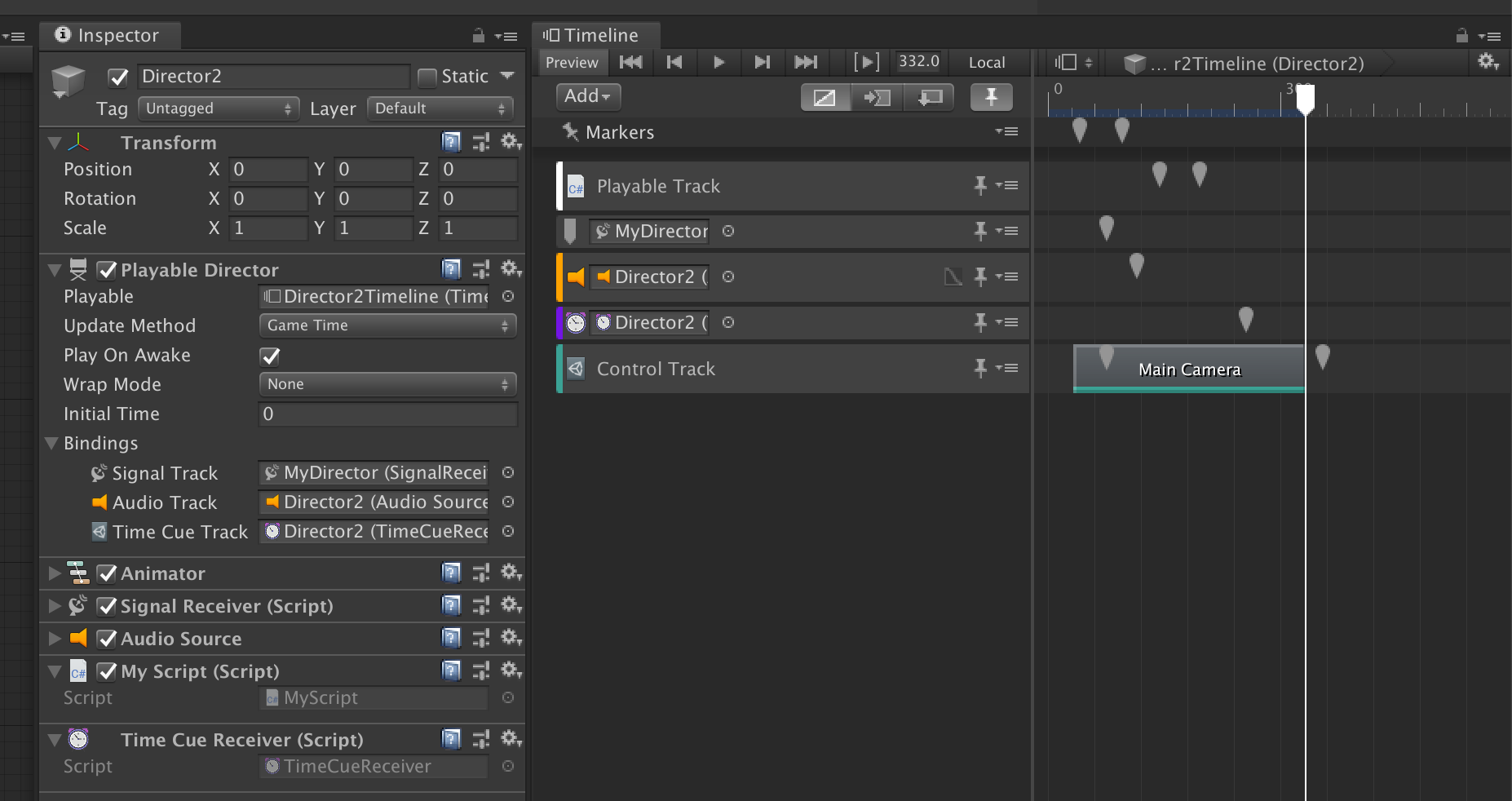
You notice a smaller track named "Markers" on every timeline asset in 2019.1. This is a new built-in markerTrack property on every TimelineAsset.
Also it is possible to create your own this smaller track by instead of inheriting from TrackAsset, inherit from MarkerTrack instead. You will then get a smaller drawer, also it will not allow any clips on it.
On contrary, the marker could be on any track, even overlapping with the clip. As far as I know you cannot lock a certain type of Marker on a certain type of MarkerTrack. Unity also made one MarkerTrack called SignalTrack. More on this at the end.
I created a single custom Marker called TimeCueMarker which you see scatterred around, and a custom MarkerTrack colored purple with output locked to TimeCueReceiver. You see even on Unity's SignalTrack, I could still put my own kind of marker (other than SignalEmitter marker that supposed to go there) on it.
You could guess what I am going for on that purple track. I am making a plugin called Time Cue, which provide new markers that affect the TimelineAsset's playable graph's playback like jump from cue to cue, or execute conditional pause/resume when it reaches a certain cue. This graph control will be via the special INotificationReceiver called TimeCueReceiver, that knows the PlayableDirector that creates the graph that is sending this notification in the first place, and could manipulate the graph also using that PlayableDirector. (Infinite loop incoming!)
Who's the receiver?
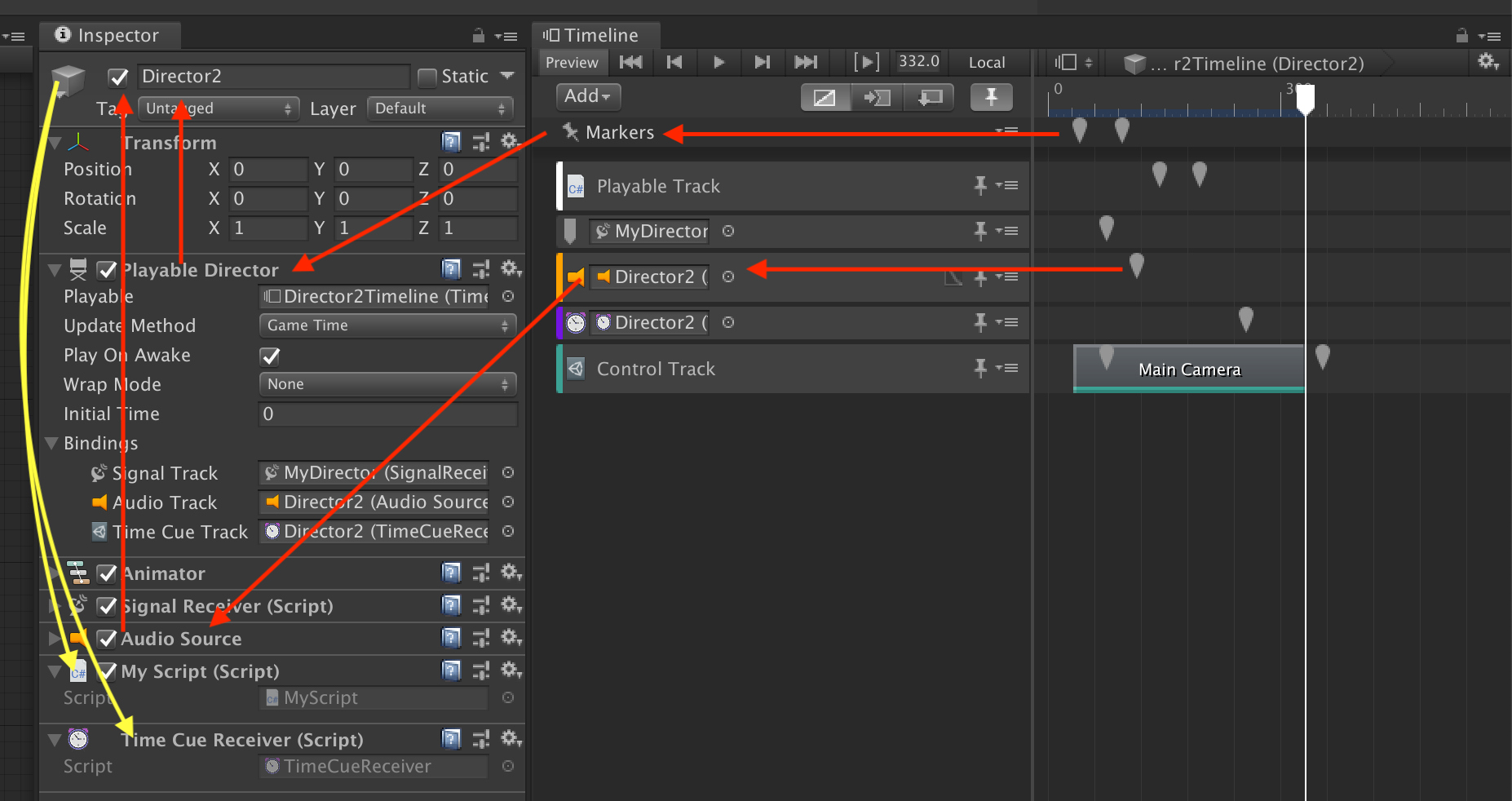
When PlayableDirector turned (2019.1) timeline asset into a graph, now it will take time to set up AddNotificationReceiver too so they receive an INotification from markers.
- If that track is the special "Marker" track (reveal with the pin button) it first find a GameObject that has
PlayableDirectorthat is governing the playable graph generated from thisTimelineAsset. (red arrows) - If that track has an output binding, it first find a GameObject that has that output component. (red arrows)
- The
GameObjectis then search for ALL of its components for anything withINotificationReceiverto add as a receiver. (yellow arrows)
Imagine MyScript you see on the Inspector which is a : MonoBehaviour, INotificationReceiver as this :
public class MyScript : MonoBehaviour, INotificationReceiver
{
public void OnNotify(Playable origin, INotification notification, object context)
{
Debug.Log($"JAM JAM REGGAE {notification}");
}
}
It could receive OnNotify from the special Marker track and also from the orange audio track as well even though you don't see any connection of audio track to this script at glance. Because it goes from component to GameObject first, then broadcast the notification back down to every components. (You could also lock the track to bind to GameObject to remove the component -> GameObject step)
Look at control track and playable track, because those track don't have any bindings markers on them are useless.
As you could imagine the receiver could receive all sorts of markers given how lenient it is and how the marker could even stay anywhere. But on your INotificationReceiver's OnNotify(Playable origin, INotification notification, object context), you can still do something like if( notification is TimeCueMarker) for example to look for the type of marker you want.
Receiver's problem
The INotificationReceiver's callback being of signature OnNotify(Playable origin, INotification notification, object context) left you wondering this : "Where the heck in the timeline is this notification?" Sure you could check for type with is, but you want to know a specific one. Maybe you want to do something specific if the incoming marker is that one.
Remember that your Marker is both INotification and IMarker. You can cast the INotification back to your marker subclass at the same time as if check like : if(notification is TimeCueMarker tcm) (that's C# 6.0 feature) then thanks to IMarker, you could get a time position or even its name you name the marker in the Timeline GUI.
Now you could if on the name or the time. Or even .parent to access its owning track to do something specific on receiving a specific marker.
Finally : SignalEmitter, SignalReceiver, SignalAsset
Instead of your own custom type of marker, a new built-in SignalEmitter is a Marker that could be tagged with SignalAsset. (Just a dumb ScriptableObject you could create)
And then in the SignalReceiver which is an INotificationReceiver, instead of if ing on the name or time, it could check if the SignalAsset is the one you are looking for or not for you.
Why check for asset instead of == to a string? It sounds very redundant...
- Drag and drop support and better editor support when it could query assets for you to select.
stringcould be the same, assets are ensured by Unity to have unique GUID.stringare hard to rename, it disconnects everywhere if you do so. Renaming an asset will keep the GUID as long as you do it inside Unity that it could also migrate the.metafile.- Asset are version controlled.
- One team member (designer) could create an asset, push it for the programmer, and the designer can continue using that asset independently without talking to the programmer ever again.
- You gain automatic support from everything related to asset. For example Addressable Asset System. You can make a DLC which use the same marker as your main game, without having the marker in the DLC package because it remembers only the GUID of the asset.
- If you are thinking you now need hundreds of signal assets, calm down. For example most of my game only use a signal asset named "SequenceFinished" and "DelayEnded". You could name it generically and reuse them. It's not like the notification will be broadcast to the world and cause conflict.
Now that's short thanks to bottom-up learning. Time to say good bye to those yield return new WaitForSeconds in your script. Have a nice day!